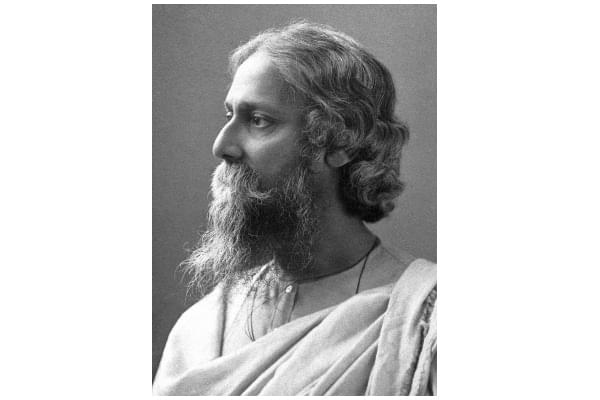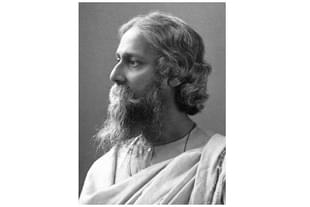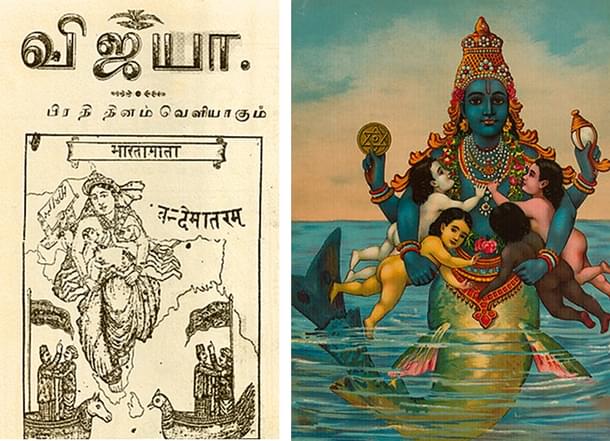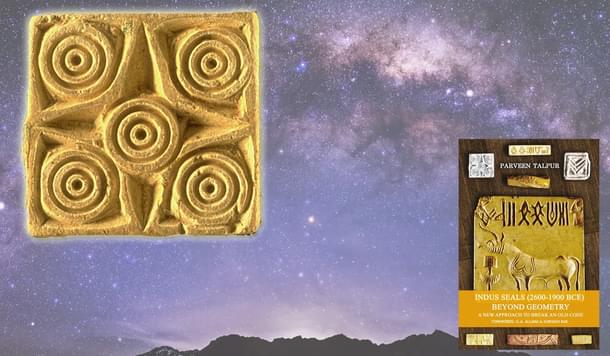Ideas
Bharathi, Tagore, And The Eyes That Do Not Blink
Aravindan Neelakandan
May 08, 2019, 05:23 AM | Updated 05:23 AM IST
Save & read from anywhere!
Bookmark stories for easy access on any device or the Swarajya app.


In 1909, Mahakavi Subramanya Bharathi of Tamil Nadu, then living in the French territory of Pondicherry, became an editor of an evening daily named Vijaya. The front page of Vijaya published on 4 September 1909 carried a picture of Bharat Mata. In this, Mother India stands on the territorial map while nourishing four children representing, four religious communities, including the Muslims.
The form of Bharat Mata that Bharathi used in his magazine derives heavily from a famous calendar art lithograph of that time - Maha Vishnu taking the fish-avatar and rescuing the four Vedas stolen by one Hayagriva. The four Vedas in the form of children cling to Vishnu who holds them like a mother.
The choice of the image of the avatar of Maha Vishnu for a poster of Bharat Mata may not just be accidental or merely an artistic convenience. Bharathi was one poet who in his poems identified Mother India explicitly with the consort of Shiva. And it is a hoary tradition in South India to identify Vishnu as the feminine part of Shiva.

Chilapathikaram ('Epic of the ankle bracelet', 3rd to 5th century CE) also attributes the doings of both Shiva and Krishna to the Goddess. So she was the one who killed the demonic wheel sent by Kamsa and she was also the one who drank the poison. The poet says that even the devas who drank the amrit would have to dissolve with the cosmic cycle but the Goddess who drank the poison is eternal and ever present. The eighth century hymn by Karaikal Ammayar, a female ascetic, who, in legends voluntarily assumed the demonic form, describes this unique form of Shiva:
One part of you is Maal (Vishnu) who measured out the world
And another is Uma the Goddess; So on both sides
We see you not (in male form) and hence feel if
Your very form is feminine perhaps. (Thirumurai 11:04:41)
Hence when Bharathi used the lithograph of Vishnu to depict Bharat Mata who he identified with Shakti he was following an ancient tradition.
What is astonishing is the continuity of this tradition manifesting in Gurudev Rabindranath Tagore’s famous Bharoto Bhagyo Bidhata, the five stanza hymn composed in 1911 and published in 1912. The first stanza of this poem is the national anthem of India.
Now as it is well known, the third stanza of the poem speaks about wheels of the chariot of 'the eternal charioteer'( 'He chirasarathi, tava radhacakre mukharita patha dinaratri') and he with the sound of his conch shell reverberates through all the chaos, and is the one who delivers us from tragedies and ('Daruna biplaba-majhe taba sankhadhvani vaje Sankataduhkhatrata'). Clearly the Krishna-related imagery emerges here.
Then, in the fourth stanza, the poet speaks about the dark night enveloping the nation. And he discovers that the ‘auspicious, ever-wakeful, downward looking wink-less eyes’ of the mother provides protection even as we go through nightmares ('Jagrata chila tava avicala mangala natanayane animese Duhsvapne atanke raksha karile anke Snehamayi tumi Mata').
The imagery that Gurudev invokes here is a primordial Indic imagery. Historian and archaeologist Parveen Talpur in her book Indus Seals (2600-1900 BCE) Beyond Geometry'(2017) when studying the Kot Diji Phase Button Seal from Harappa (H-1535) refers to the suggestion of Indologist Asko Parpola 'that the circle with a dot motif represents eye'. She then points out that the Varuna eternally watches his subjects from the skies through the stars which are his thousand-eyes. 'Furthermore, Parpola compares gods’ eyes with fish eyes, as both are unwinking', writes Dr Talpur. Varuna is also has a motherly nature as well. 'Varuna is the womb' says Satapatha Brahmana 12.9.1.17.

While the third eye of Shiva is associated with the destructive power in the popular mind, the invocation hymn of Akanaanooru of Sangham literature (300 BCE to 200 CE) calls the third eye of Shiva as the eye that never winks. Chilapathikaram associates this very eye with that of the Goddess. In the Soundarya Lahari of Adi Sankaracharya (7th or 8th century CE), he specifically refers to the protective function of the wink-less nature of the eyes of the Goddess:
Daughter of the king of Mountains! Seers reveal that the universe goes through dissolution and emergence by wink of Your eyes. But, I think that the whole universe is protected by You keeping Your eyes from winking (parihrta nimesas)
For the Tamils, the Goddess with the wink-less eyes at once shall bring to mind Meenakshi - the fish-eyed Goddess of Madurai. She is also 'Ankayarkanni', the beautiful fish-eyed Goddess. Here, the most important meaning associated with the name in the bhakti tradition of Tamil Nadu is that her eyes being wink-less are ever protective and nurturing (pertaining to the myth that the fish nurtures her young ones with her mere gazing at them). 'Her eyes are the fish that swim in the flood of Her beauty which is Her face' says Sri Lalitha Sahasranama.
Commentators, when discussing this name point to the nurturing quality of the wink-less fish-eyes. Sahasranama also speaks of how when the Goddess just through winking creates multiple universes. Thus while the winking of her eyes can create and destroy existence, it is her wink-less gaze that protects and nurtures. Incidentally, amongst the Hindu Trimurtis it is Vishnu who nurtures and protects all existence.

Thus connecting all the dots one can see in that phrase ‘tava avicala mangala natanayane animese’ that came to Gurudev Tagore the eternal wisdom of India - the Harappan-Vedic eye of Varuna, to the wink-less eye of the Goddess sang by bhakti poets as well as by the great Advaitin Adi Shankara himself. The fact that Rabindranath Tagore came from the Brahmo lineage that abhorred the so-called image worship, and yet delivered these lines that contain an imagery of the Goddess as found pan-India, is a telling manifestation of another movement of Mother India - Samanvaya.
Aravindan is a contributing editor at Swarajya.





